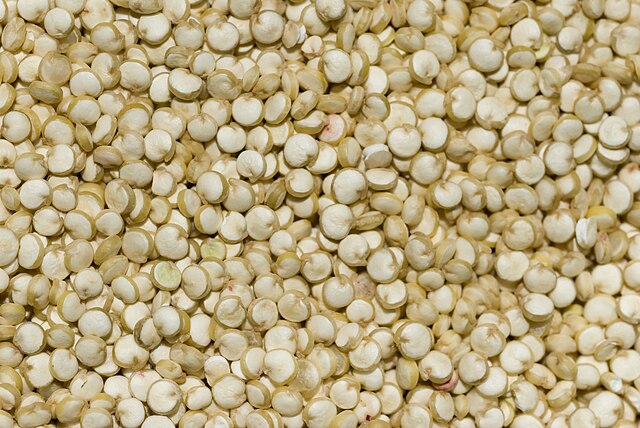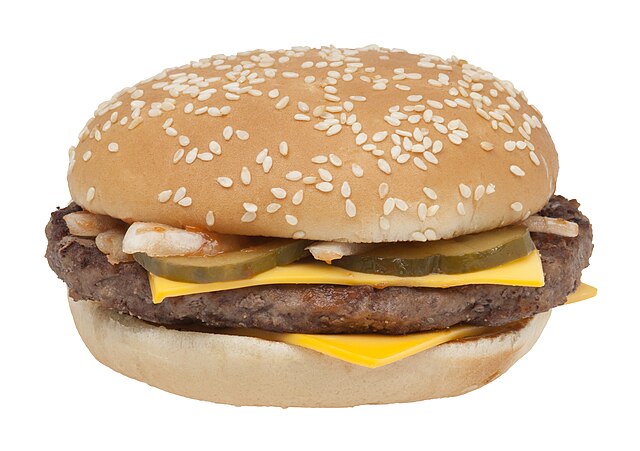Quinoa vs. Quarter Pounder
Nutrition comparison of Cooked Quinoa and Quarter Pounder
Ever wonder how your favorite foods stack up against each other in terms of nutrition?
We compared the nutritional contents of
cooked
quinoa
versus
quarter pounder
(100g each)
below using 2020 USDA and NIH data[1].
For a quick recap of significant nutrients and differences in quinoa and quarter pounder:
- Both quinoa and quarter pounder are high in calories.
- Quarter pounder has more riboflavin, niacin and Vitamin B12, however, quinoa contains more Vitamin B6.
- Quarter pounder is a great source of iron and potassium.
- Quarter pounder is an excellent source of calcium and protein.
- Quinoa has 4.9 times less sugar than quarter pounder.
- Quinoa has signficantly less saturated fat than quarter pounder.
- Quinoa is a great source of dietary fiber.
USDA sources for nutritional information: Quinoa (Quinoa, cooked) and Quarter Pounder (McDONALD'S, QUARTER POUNDER) . Have a correction or suggestions? Shoot us an email.
Calories and Carbs
calories
Both quinoa and quarter pounder are high in calories. Quarter pounder has 103% more calories than quinoa - quinoa has 120 calories per 100 grams and quarter pounder has 244 calories.
For macronutrient ratios, quinoa is lighter in protein, much heavier in carbs and much lighter in fat compared to quarter pounder per calorie. Quinoa has a macronutrient ratio of 15:71:14 and for quarter pounder, 23:36:42 for protein, carbohydrates and fat from calories.
Macro Ratios from Calories:
| Quinoa | Quarter Pounder | |
|---|---|---|
| Protein | 15% | 23% |
| Carbohydrates | 71% | 36% |
| Fat | 14% | 42% |
| Alcohol | ~ | ~ |
carbohydrates
Quinoa and quarter pounder contain similar amounts of carbs - quinoa has 21.3g of total carbs per 100 grams and quarter pounder has 22.2g of carbohydrates.
dietary fiber
Quinoa is a great source of dietary fiber and it has 75% more dietary fiber than quarter pounder - quinoa has 2.8g of dietary fiber per 100 grams and quarter pounder has 1.6g of dietary fiber.
sugar
Quinoa has 4.9 times less sugar than quarter pounder - quinoa has 0.87g of sugar per 100 grams and quarter pounder has 5.1g of sugar.
Protein
protein
Quarter pounder is an excellent source of protein and it has 220% more protein than quinoa - quinoa has 4.4g of protein per 100 grams and quarter pounder has 14.1g of protein.
Fat
saturated fat
Quinoa has signficantly less saturated fat than quarter pounder - quinoa has 0.23g of saturated fat per 100 grams and quarter pounder has 4g of saturated fat.
cholesterol
Quinoa has less cholesterol than quarter pounder - quarter pounder has 39mg of cholesterol per 100 grams and quinoa does not contain significant amounts.
Vitamins
Vitamin C
Quarter pounder has more Vitamin C than quinoa - quarter pounder has 0.9mg of Vitamin C per 100 grams and quinoa does not contain significant amounts.
Vitamin A
Quarter pounder has more Vitamin A than quinoa - quarter pounder has 16.8ug of Vitamin A per 100 grams and quinoa does not contain significant amounts.
Vitamin E
Quinoa has more Vitamin E than quarter pounder - quinoa has 0.63mg of Vitamin E per 100 grams and quarter pounder does not contain significant amounts.
The B Vitamins
Quarter pounder has more riboflavin, niacin and Vitamin B12, however, quinoa contains more Vitamin B6. Both quinoa and quarter pounder contain significant amounts of thiamin and folate.
| Quinoa | Quarter Pounder | |
|---|---|---|
| Thiamin | 0.107 MG | 0.183 MG |
| Riboflavin | 0.11 MG | 0.344 MG |
| Niacin | 0.412 MG | 4.452 MG |
| Vitamin B6 | 0.123 MG | ~ |
| Folate | 42 UG | 56 UG |
| Vitamin B12 | ~ | 1.28 UG |
Minerals
calcium
Quarter pounder is an excellent source of calcium and it has 394% more calcium than quinoa - quinoa has 17mg of calcium per 100 grams and quarter pounder has 84mg of calcium.
iron
Quarter pounder is a great source of iron and it has 62% more iron than quinoa - quinoa has 1.5mg of iron per 100 grams and quarter pounder has 2.4mg of iron.
potassium
Quarter pounder is a great source of potassium and it has 32% more potassium than quinoa - quinoa has 172mg of potassium per 100 grams and quarter pounder has 227mg of potassium.
Customize your serving size
The comparison below is by weight, but sometimes 100g isn't that intuitive of a measurement for food. View a custom portion comparison (e.g. cups, oz, package).
You can try adding or subtracting the amount of either Quinoa or Quarter Pounder .
Note: The specific food items compared are: Quinoa (Quinoa, cooked) and Quarter Pounder (McDONALD'S, QUARTER POUNDER) .
Cooked Quinoa 100g
(
100 g
)
|
Daily Values (%) |
Quarter Pounder 100g
(
100 g
)
|
|||||
|---|---|---|---|---|---|---|---|
| 120KCAL 6% |
|
5% | calories | 103% |
|
244KCAL 12% | |
| 21G 9% |
|
5% | carbohydrates | 5% |
|
22G 9% | |
| 2.8G 11% |
|
75% | dietary fiber | 5% |
|
1.6G 6% | |
| 0.87G | 5% | sugar | 486% | 5.1G | |||
| 1.9G 3% |
|
5% | total fat | 532% |
|
12G 18% | |
| 0.23G 1% |
|
5% | saturated fat | >999% |
|
4G 22% | |
| 0.53G | 5% | monounsaturated fat | 692% | 4.2G | |||
| 1.1G | 293% | polyunsaturated fat | 5% | 0.28G | |||
| 5% | cholesterol | >999% | 39MG | ||||
| 7MG 1% |
|
5% | sodium | >999% |
|
427MG 29% | |
| 5% | Vitamins and Minerals | 5% | |||||
|
|
5% | Vitamin A | >999% |
|
17UG 2% | ||
|
|
5% | Vitamin C | >999% |
|
0.9MG 1% | ||
| 17MG 2% |
|
5% | calcium | 394% |
|
84MG 8% | |
| 1.5MG 8% |
|
5% | iron | 60% |
|
2.4MG 13% | |
| 64MG 21% |
|
191% | magnesium | 5% |
|
22MG 7% | |
| 172MG 8% |
|
5% | potassium | 32% |
|
227MG 10% | |
| 0.11MG 10% |
|
5% | thiamin (Vit B1) | 64% |
|
0.18MG 17% | |
| 0.11MG 10% |
|
5% | riboflavin (Vit B2) | 209% |
|
0.34MG 31% | |
| 0.41MG 3% |
|
5% | niacin (Vit B3) | 997% |
|
4.5MG 32% | |
| 0.12MG 10% |
|
>999% | Vitamin B6 | 5% |
|
||
| 42UG 11% |
|
5% | folate (Vit B9) | 33% |
|
56UG 14% | |
|
|
5% | Vitamin B12 | >999% |
|
1.3UG 53% | ||
| 0.63MG 4% |
|
>999% | Vitamin E | 5% |
|
||
| 4.4G 9% |
|
5% | protein | 218% |
|
14G 28% | |
| 23MG 5% |
|
>999% | choline | 5% |
|
||
| 0.19MG 16% |
|
73% | copper | 5% |
|
0.11MG 9% | |
| 0.63MG 35% |
|
215% | manganese | 5% |
|
0.2MG 11% | |
| 152MG 22% |
|
23% | phosphorus | 5% |
|
124MG 18% | |
| 2.8UG 5% |
|
>999% | selenium | 5% |
|
||
| 1.1MG 14% |
|
5% | zinc | 145% |
|
2.7MG 34% | |
| 72G | 44% | Water | 5% | 50G | |||
| 18G | >999% | Starch | 5% | ||||
NO SIGNIFICANT AMOUNTS (either food): Alcohol, chlorine, chromium, fluoride, iodine, molybdenum, Vitamin D, pantothenic acid (Vit B5), biotin (Vit B7), Vitamin K, trans fat. |
|||||||
FAQ
Does quinoa or quarter pounder contain more calories in 100 grams?Both quinoa and quarter pounder are high in calories. Quarter pounder has 100% more calories than quinoa - quinoa has 120 calories in 100g and quarter pounder has 244 calories.
Does quinoa or quarter pounder have more carbohydrates?
By weight, quinoa and quarter pounder contain similar amounts of carbs - quinoa has 21.3g of carbs for 100g and quarter pounder has 22.2g of carbohydrates.
Does quinoa or quarter pounder contain more calcium?
Quarter pounder is a rich source of calcium and it has 390% more calcium than quinoa - quinoa has 17mg of calcium in 100 grams and quarter pounder has 84mg of calcium.

